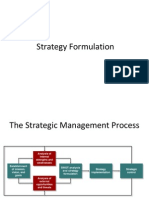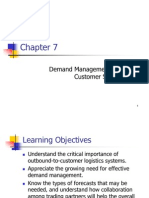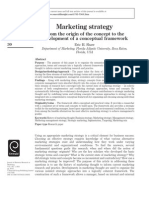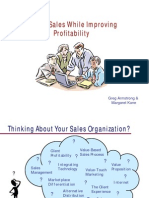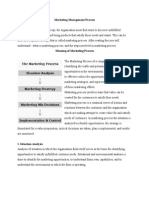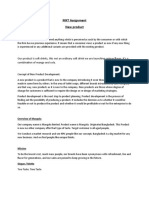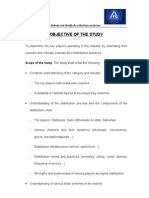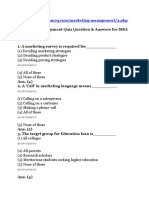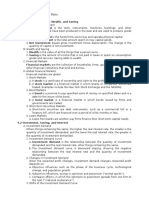Strategic Marketing Management
Strategic Marketing Management
Uploaded by
Mobi SaitCopyright:
Available Formats
Strategic Marketing Management
Strategic Marketing Management
Uploaded by
Mobi SaitOriginal Description:
Copyright
Available Formats
Share this document
Did you find this document useful?
Is this content inappropriate?
Copyright:
Available Formats
Strategic Marketing Management
Strategic Marketing Management
Uploaded by
Mobi SaitCopyright:
Available Formats
Figures and Graphs
2012 Alexander Chernev
The Role of Frameworks in Marketing Management
Framework
Typical problem
Abstraction Specific problem
Typical solution
Application Specific solution
Trial & error
The 3-V Principle of Managing Value
Company value
OVP
Customer value
Collaborator value
Optimal value proposition
The G-STIC Framework for Action Planning
Goal Strategy Tactics Implementation
Control
Identifying Target Markets: The 5-C Framework
Customers
Customers
Customers
Competitors
Competitors
Competitors
Context
Context
Context
Identifying Target Customers & Developing a Value Proposition
Company value Customers Value
OV P
Customer value
Competitors
Collaborator value
Context
Customers
Value
Company value
OVP
Customer value
Competitors
Collaborator value
Context
Designing the Tactics
Product
Service
Brand
Product
Service
Brand
Incentives
OVP
Price Distribution
Incentives
OVP
Price
Communication
Communication
Distribution
Product
Service
Brand
Incentives
OVP
Price
Communication
Distribution
Developing an Action Plan: The Big Picture
Goal Focus Benchmarks
Strategy Target market Tactics Product Incentives Service Brand Price Distribution Communication Implementation Organizational infrastructure Business processes Control Performance evaluation Environmental analysis Implementation schedule Value proposition
Goal
Focus Benchmarks
Strategy
Target market Product Incentives Service Value proposition Brand Price Distribution
Tactics
Communication
Implementation
Organizational infrastructure Business processes Implementation schedule
Control
Performance evaluation Environmental analysis
Segmentation, Mass Marketing, & One-to-One Marketing
Offering
Customer Customer Customer Customer Customer Customer
1 2 3 4 5 6
Offering A
Offering B
Customer Customer Customer Customer Customer Customer
1 2 3 4 5 6
Offering A Offering B Offering C Offering D Offering E Offering F
Customer Customer Customer Customer Customer Customer
1 2 3 4 5 6
Mass marketing
Segment-based marketing
One-to-one marketing
Market Segmentation Strategies
Non-segmented market
Segmentation I
Segmentation II
Segmentation III
Strategic Targeting: Selecting Value-Based Segments
Segment A Segment B Segment C
Tactical Targeting: Linking Value and Profile Segments
Demographics Behavior
Geography Psychographics
2006 Alexander Chernev
Tactical Targeting Scenarios
Sniper targeting (perfect fit)
Shotgun targeting (broad)
Oversegmentation (narrow)
Shot-in-the-dark (misaligned)
Value-based segment (unobservable) Profile-based-segment (observable)
2006 Alexander Chernev
Multi-Segment & Single-Segment Product Line Strategies
Target segment C1 Target segment C2 Target segment C2
Segmentation
Targeting Offering 1 Action plan C1 Offering 3 Action plan C3
Offering 2 Action plan C2
The Three Dimensions of Customer Value
Functional value Customer value Monetary value Psychological value
2006 Alexander Chernev
Competitive Advantage: A Source of Customer Value
Irrelevant attributes Irrelevant attributes Strengths Competitive advantage Strengths Weaknesses Competitive parity Shared attributes
Weaknesses Shared attributes
Offering A
Offering B
The Concept of Economic Value Analysis
Functional value Customer value Monetary value
Monetizing functional value Monetizing psychological value
Psychological value
Economic Value as a Function of the Differences in Total Costs
Difference in total cost
Cost of ownership
Cost of ownership
Difference in price Price
Price
Offering X
Offering Y
Attribute-Value Map
Customer value Companys offering k Competitive offering A l Competitive offering B j Competitive advantage k Competitive parity l Competitive disadvantage Attribute 1 Attribute 2 Attribute 3 Attribute 4 Attribute 5
Positioning Map
Attribute 1
Offering A Offering B
Offering C Attribute 2
Offering D
Offering E
The Three Dimensions of Company Value
Monetary value Customer value Functional value Psychological value
Creating Company Value: Profit-Growth Analysis
Volume Revenues Price Net income
New Customers Current customers
New to the category Competitors customers
COGS Costs Marketing
Other
Strategies for Managing Sales Growth
Customers new to the category Sales volume Competitors customers Current customers
Managing adoption Managing usage
The SWOT Framework
Favorable factors Internal factors
External factors
Unfavorable factors
Strengths
Weaknesses
Company analysis
Market analysis
Opportunities
Threats
Product-Market Growth Matrix
Current customers New customers Current products New products Market penetration Product development Market development Diversification
Conflicts in Vertical Collaboration
Manufacturer
Manufacturer
Distributor
Distributor A
Distributor B
Customer Vertical channel conflict
Customer
Horizontal channel conflict
Conflicts in Horizontal Collaboration
Company
Collaborator
Customer
Steal-Share Strategy
Current users
Market-Growth Strategy
Current users
New users
Market-Growth Strategy for a Superior Offering
Current users
New users
Market-Innovation Strategy
Current users Current market
New users
New market
Defensive Marketing Strategies
Custome r costs
Do nothin g Move downscale
Move upscale
Launch premium offering Increas e benefits
Launch economy offering
Reduce costs
Customer benefits
The Five Forces of Competition
New entrants 3
Suppliers
Competitors 5
Buyers
4 Substitutes
1 Bargaining power of suppliers 2 Bargaining power of buyers 3 Threat of new entrants 4 Threat of substitutes 5 Rivalry among extant competitors
Product/Service Management as a Value-Creation Process
Product Service
Company value
OV P
Customer value
Collaborator value
Context
Product Service
Company value
OVP
Customer value
Collaborator value
Context
Managing Products by Streamlining the Marketing Mix
Brand
Price
Service
Product
Incentives
Distribution
Communication
Brand
Price
Service
Product
Incentives
Distribution
Communication
Branding as a Value-Creation Process
Company value
Customer value
OV P
Brand
Collaborator value
Context
Company value
Customer value
OVP
Brand
Collaborator value
Context
Managing Brands by Streamlining the Marketing Mix
Service
Incentives
Product
Brand
Distribution
Price
Communication
Service
Incentives
Product
Brand
Distribution
Price
Communication
Pricing as a Value-Creation Process
Company value
Customer value
OV P
Price
Collaborator value
Context
Company value
Customer value
OVP
Price
Collaborator value
Context
Managing Price by Streamlining the Marketing Mix
Brand
Incentives
Product
Price
Distribution
Service
Communication
Brand
Incentives
Product
Price
Distribution
Service
Communication
Managing Incentives as a Value-Creation Process
Company value
Incentives
OV P
Customer value
Collaborator value
Context
Company value
Incentives
OVP
Customer value
Collaborator value
Context
Managing Incentives by Streamlining the Marketing Mix
Service
Brand
Product
Incentives
Distribution
Price
Communication
Service
Brand
Product
Incentives
Distribution
Price
Communication
Pull and Push Promotion Strategies
Push strategy Manufacturer Demand Incentives Communications
Pull strategy Manufacturer Demand Retailer Demand Customer
Retailer
Demand Incentives Communications
Incentives Communications
Customer
Communications as a Value-Creation Process
Communication
Company value
OV P
Customer value
Collaborator value
Context
Communication
Company value
OVP
Customer value
Collaborator value
Context
Managing Communications by Streamlining the Marketing Mix
Service
Brand
Product
Communication
Distribution
Price
Incentives
Service
Brand
Product
Communication
Distribution
Price
Incentives
Planning a Communication Campaign
Goal Message Media Creative solution Implementation Control
Distribution as a Value-Creation Process
Company value
Distribution
OV P
Customer value
Collaborator value
Context
Company value
Distribution
OVP
Customer value
Collaborator value
Context
Managing Distribution by Streamlining the Marketing Mix
Service
Brand
Product
Distribution
Incentives
Price
Communication
Service
Brand
Product
Distribution
Incentives
Price
Communication
Distribution Channel Structure
Company
Wholesaler
Retailer
Retailer
Customer
Direct channel
Customer
Customer
Indirect channels Hybrid channel
Managing Sales Growth
New customers
Managing Sales Growth Current customers
Managing adoption Managing usage
The Adoption Funnel
Awareness Understanding Attractiveness Affordability Availability Purchase intent Purchase
Identifying Adoption Gaps
j
All target customers Aware of the offerings existence
m
Can afford the offering
n
Have access to the offering
o
Intend to purchase the offering
Understand Perceive the the offerings offering to be benefits attractive
Purchased the offering
Identifying Actionable Goals
Offering attractiveness
Usage frequency
Consumption quantity
Usage quantity
Replacement frequency
Offering availability
Identifying Consumption Gaps
Satisfaction
Usage frequency
Usage quantity
Replacement frequency
Availability
The Typical S-Shaped Pattern of New Product Adoption
Total adoptions
Number of adoptions
Speed of diffusion
Inflection point
Market potential
Time
Time
Managing the Product Life Cycle
Sales
Introduction Market size Market growth Competition Small Low Low
Growth Moderate High Moderate
Maturity Large Low High
Decline
Time
Moderate/Small Negative Moderate/Low
Extending Product Life Cycle through Innovation
Sales revenues
Third generation
Second generation
First generation
Time
Rogers Model of Adoption of Innovation
Number of adoptions
2.5% Innovators
13.5% Early adopters
34% Early majority
(x-SD) (x)
34% Late majority
16% Laggards
Time
(x-2SD)
(x+SD)
Moores Technology Adoption Model
Number of adoptions
The chasm
Enthusiasts
Visionaries
Pragmatists
Conservatives
Skeptics
Time
Early market
Mainstream market
Vertical Extensions
Price
Upscale offering
Downscale offering Benefits
Horizontal Extensions
Price
Offering A
Offering B
Benefits
Managing Product-Line Cannibalization
Existing offering s
Existing offerings
Existing offerings
Loss of share due to cannibalization New offering
New offering
Competitive offerings
Competitive offerings
Competitive offerings Dual-offering scenario with cannibalization
Single-offering scenario
Dual-offering scenario with cannibalization
The Fighting-Brand Strategy
Price Quality
Incumbent brand
Low-price competitors Fighting brand Time
The Sandwich Strategy
Price Quality
Incumbent brand
Premium brand
Low-price competitors Fighting brand Time
The Good-Better-Best Strategy
Price Quality
Incumbent brand
Best Better Low-price competitors Good Time
The Typical S-Shaped Pattern of New Product Adoption
Cumulative number of adoptions
Speed of diffusion
Inflection point
Market potential
Time
The Typical Bell-Shaped Pattern of New Product Adoption
Number of adoptions
Time
Extra Figures and Graphs
2012 Alexander Chernev
Strategic and Tactical Targeting
Strategic targeting involves deciding which segments to serve and which to ignore
Segmentation
Targeting
Tactical targeting involves identifying the profile of the already selected target customers
Segmentation
Targeting (strategic)
Targeting (tactical)
Identification (communication) (distribution)
Developing a Value Proposition and Positioning
Benefits
Costs
Primary benefit
Segmentation
Group customers into need-based segments
Targeting
Value proposition
Positioning
Identify the primary benefit of the offering
Select target segments Create a relevant and identify means to value proposition reach these segments
You might also like
- Integrated Marketing Communications Strategic Planning 5th Edition - MARK 3340 Textbook 2Document476 pagesIntegrated Marketing Communications Strategic Planning 5th Edition - MARK 3340 Textbook 2kyrstyn89% (9)
- Summary Exploring Strategy Chapter 1-15Document69 pagesSummary Exploring Strategy Chapter 1-15Um Angel100% (2)
- Marketing - Marketing Management and Strategy 4th Edition PDFDocument461 pagesMarketing - Marketing Management and Strategy 4th Edition PDFishan66666100% (10)
- Aaker - Strategic Market ManagementDocument10 pagesAaker - Strategic Market ManagementRevvie0% (14)
- Alexander Chernev - Strategic Brand Management, 2nd EditionDocument253 pagesAlexander Chernev - Strategic Brand Management, 2nd EditionNguyen Thi Thuy Dung100% (6)
- Consumer Behavior and Culture PDFDocument590 pagesConsumer Behavior and Culture PDFTo Quynh Chi100% (4)
- Credit Pitch Overview - SampleDocument15 pagesCredit Pitch Overview - SampleChintu KumarNo ratings yet
- Identity-Based Brand Management - Fundamentals-Strategy-Implementation-Controlling (PDFDrive)Document324 pagesIdentity-Based Brand Management - Fundamentals-Strategy-Implementation-Controlling (PDFDrive)Nguyen Thi Thuy DungNo ratings yet
- CIM HANDBOOK of Strategic MarketingDocument298 pagesCIM HANDBOOK of Strategic Marketingadelineo vlog O100% (4)
- Ecosystem of MarketingDocument5 pagesEcosystem of MarketingMuskan FatimaNo ratings yet
- Strategic Marketing Concepts and CasesDocument159 pagesStrategic Marketing Concepts and CasesSorin Nastas100% (1)
- Strategic Marketing ManagementDocument234 pagesStrategic Marketing ManagementMary Ann Gabion100% (1)
- Handbook of Pricing Research in Marketing PDFDocument616 pagesHandbook of Pricing Research in Marketing PDFOfelia Ragpa100% (1)
- Strategy Formulation v2 9-4-12Document98 pagesStrategy Formulation v2 9-4-12Ay Ar Ey ValenciaNo ratings yet
- Chapter 7 - Demand Management and Customer ServiceDocument61 pagesChapter 7 - Demand Management and Customer ServiceArmanNo ratings yet
- Practical Guide Introduction To Marketing v3Document10 pagesPractical Guide Introduction To Marketing v3Raveesh HurhangeeNo ratings yet
- Sales and Distribution ManagementDocument21 pagesSales and Distribution Managementshubhro gomesNo ratings yet
- Burberry 2020-21 Strategic ReportDocument145 pagesBurberry 2020-21 Strategic ReportLinh Phuong NguyenNo ratings yet
- Brand Growth Strategies - Brand ManagementFinalDocument82 pagesBrand Growth Strategies - Brand ManagementFinalmhlak100% (1)
- Managing Markets Customers by Elearn (Elearn Training Company)Document131 pagesManaging Markets Customers by Elearn (Elearn Training Company)HIBA100% (1)
- Slides of Strategic MarketingDocument70 pagesSlides of Strategic Marketinganon_852565654100% (1)
- Strategic Marketing Management v1.61 PDFDocument50 pagesStrategic Marketing Management v1.61 PDFNaxilo78% (9)
- Concepts of Brand ManagementDocument263 pagesConcepts of Brand ManagementMartin Guy Choquette89% (9)
- Marketing Ethics and CSRDocument3 pagesMarketing Ethics and CSRStanley CheruiyotNo ratings yet
- International Marketing, Market Selection, Modes of Entry in International MarketsDocument36 pagesInternational Marketing, Market Selection, Modes of Entry in International MarketscharurastogiNo ratings yet
- Strategic MarketingDocument464 pagesStrategic Marketingusmanmani1100% (6)
- Marketing Research Text and CasesDocument411 pagesMarketing Research Text and Casesastrojin100% (4)
- Marketing StrategyDocument110 pagesMarketing StrategyMSA-ACCA80% (5)
- Ch01 David AakerDocument30 pagesCh01 David Aakerpankhil_maru75% (4)
- Lecture-16-Pricing-Understanding and Capturing Customer ValueDocument31 pagesLecture-16-Pricing-Understanding and Capturing Customer ValueMarcus ReusNo ratings yet
- Power Point Presentation On Pricing Strategy and Brand ManagementDocument34 pagesPower Point Presentation On Pricing Strategy and Brand Managementlegese lemmaNo ratings yet
- Strategic Marketing Final NotesDocument63 pagesStrategic Marketing Final NotesKamrul Khan100% (2)
- Resouce Based TheoryDocument327 pagesResouce Based Theorynashrf100% (1)
- Strategic MarketingDocument207 pagesStrategic Marketingwaqarawan1No ratings yet
- Strategic Marketing ManagementDocument23 pagesStrategic Marketing ManagementKhawaja Jawad100% (1)
- Strategic Marketing 8th Edition - TEXT BOOKDocument585 pagesStrategic Marketing 8th Edition - TEXT BOOKweni ibrahim100% (1)
- The Strategy and Tactics of Pricing PDFDocument46 pagesThe Strategy and Tactics of Pricing PDFRoger Ignacio33% (3)
- Principles Marketing-WEB PDFDocument713 pagesPrinciples Marketing-WEB PDFJohn Paul Sykioco100% (3)
- Professional Salesmanship Chap01Document34 pagesProfessional Salesmanship Chap01Hannah BarrientosNo ratings yet
- Marketing Research-Practical GuideDocument291 pagesMarketing Research-Practical GuideKyaw Linn HtetNo ratings yet
- Chapter 1 - MARKETING Creating and Capturing Customer ValueDocument7 pagesChapter 1 - MARKETING Creating and Capturing Customer ValueMaria Charise Tongol100% (1)
- Chapter 1-Brands & Brand ManagementDocument20 pagesChapter 1-Brands & Brand Managementshoiraurmonova10.02No ratings yet
- T2130 Brand ManagementDocument6 pagesT2130 Brand Managementmittal_parmar5224No ratings yet
- Customer-Based Brand Equity: by Kevin Lane KellerDocument32 pagesCustomer-Based Brand Equity: by Kevin Lane KellerMuzahidul Islam RezwanNo ratings yet
- Marketing Research Midterm Exam JULY 2016Document4 pagesMarketing Research Midterm Exam JULY 2016KomlavathiNo ratings yet
- Marketing Strategy HistoryDocument26 pagesMarketing Strategy Historyshahmed9990% (1)
- Consumer Behavior Final Exam ReviwDocument11 pagesConsumer Behavior Final Exam ReviwDavid ByarsNo ratings yet
- Lecture 3. Market Research & Consumer Behavior. IDocument29 pagesLecture 3. Market Research & Consumer Behavior. ILip Keong Low100% (4)
- Course Syllabus International Marketing: Vietnam National University - HCMC International University School of BusinessDocument13 pagesCourse Syllabus International Marketing: Vietnam National University - HCMC International University School of BusinessDao CoNo ratings yet
- Marketing EnvironmentDocument26 pagesMarketing Environmentsimply_coool100% (4)
- Marketing ResearchDocument217 pagesMarketing ResearchMohammed Siyad100% (2)
- MGT301Fall2008 MidTerm OPKST MGT301 Principles of MarketingDocument9 pagesMGT301Fall2008 MidTerm OPKST MGT301 Principles of Marketingkamran haider100% (1)
- Creating Market ValueDocument16 pagesCreating Market Valuecyzyjy100% (1)
- Marketing PerformanceDocument282 pagesMarketing PerformancenadachakerNo ratings yet
- Part V - Marketing ImplementationDocument46 pagesPart V - Marketing Implementationtranvuhoaan31No ratings yet
- Conducting A Feasibility Study and Crafting A BusinessDocument29 pagesConducting A Feasibility Study and Crafting A BusinessalisamiyaNo ratings yet
- E-Marketing Planning and StrategiesDocument12 pagesE-Marketing Planning and StrategiesMohan KumarNo ratings yet
- Designing Customer ValueDocument38 pagesDesigning Customer ValueSasmi ShamsNo ratings yet
- ABA Sales Management PresentationDocument12 pagesABA Sales Management Presentationkieuchinh199No ratings yet
- A Literature Review and Classification of Relationship Marketing ResearchDocument27 pagesA Literature Review and Classification of Relationship Marketing ResearchPreet Kaur GirnNo ratings yet
- Positioning and Bran 2015 1 PDFDocument156 pagesPositioning and Bran 2015 1 PDFKrishanNo ratings yet
- Padilla V Padilla 74 Phil 377Document3 pagesPadilla V Padilla 74 Phil 377Christle PMDNo ratings yet
- Tut 3Document7 pagesTut 3Chi QuỳnhNo ratings yet
- Session - 2 - Relation MarketingDocument25 pagesSession - 2 - Relation MarketingFarhan Islam100% (1)
- Industrial Organisation & Management Industrial Economics & Management Economics and Business Management General ManagementDocument188 pagesIndustrial Organisation & Management Industrial Economics & Management Economics and Business Management General Managementpured3vilgNo ratings yet
- Table 1: Definitions of Trade Marketing, Category Management, and Shopper MarketingDocument1 pageTable 1: Definitions of Trade Marketing, Category Management, and Shopper MarketingShashank GuptaNo ratings yet
- Pengaruh Customer Relationship Management Dan Kepuasan Pelanggan Terhadap Loyalitas PelangganDocument17 pagesPengaruh Customer Relationship Management Dan Kepuasan Pelanggan Terhadap Loyalitas Pelangganranu groupNo ratings yet
- Change in D&S + Elasticity NotesDocument11 pagesChange in D&S + Elasticity NotesYuui YooNo ratings yet
- Behavioral Economics and Game TheoryDocument11 pagesBehavioral Economics and Game TheoryKEZIAH REVE B. RODRIGUEZNo ratings yet
- Dukes IndiaDocument15 pagesDukes IndiaShruti JainNo ratings yet
- Principles of Marketing Chapter 8Document36 pagesPrinciples of Marketing Chapter 8Mahmud AhmedNo ratings yet
- Paper:: 12, Market Analysis and Selection 14, Marketing ManagementDocument10 pagesPaper:: 12, Market Analysis and Selection 14, Marketing ManagementMohit RanaNo ratings yet
- Marketing Management ProcessDocument3 pagesMarketing Management ProcessSangesh NattamaiNo ratings yet
- ATW108 Chapter 28 TutorialDocument3 pagesATW108 Chapter 28 TutorialShuhada ShamsuddinNo ratings yet
- CH 10 E-Commerce Digital Markets, Digital Goods CH 10 E-Commerce Digital Markets, Digital GoodsDocument7 pagesCH 10 E-Commerce Digital Markets, Digital Goods CH 10 E-Commerce Digital Markets, Digital GoodsRidhi BNo ratings yet
- MKT AssignmentDocument6 pagesMKT AssignmentMd. Saiful HoqueNo ratings yet
- Report Distribution BiscuitsDocument133 pagesReport Distribution BiscuitsHemant ChopraNo ratings yet
- HowDocument5 pagesHowbezawitNo ratings yet
- SCM SlidesDocument15 pagesSCM SlidesAmna NoorNo ratings yet
- Marketing Concept 101Document23 pagesMarketing Concept 101gautrucduhiNo ratings yet
- EconomicsDocument145 pagesEconomicsuocstudentsappNo ratings yet
- MKT 121 MaterialDocument49 pagesMKT 121 MaterialALIU SAEED100% (1)
- Long Test On MarketingDocument30 pagesLong Test On MarketingAbdulqadir Al-Emad100% (1)
- Product:: Clothing - StoreDocument2 pagesProduct:: Clothing - Storeezazul udoyNo ratings yet
- 4 5901969381843273711Document25 pages4 5901969381843273711Ali GamalNo ratings yet
- ECN 111 Chapter 9 Lecture NotesDocument3 pagesECN 111 Chapter 9 Lecture NoteswayneNo ratings yet














